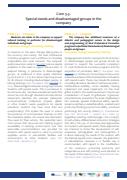Core 5.3. Special needs and disadvantaged groups in the company ITEM 5.3.1Company Measures are taken in the company to support tailored training, in particular for disadvantaged individuals and groups. Completely / Enough / Something / Nothing In response to the rapid changes taking place in the economy and society, the Dual Professional Formative programs must contribute to increasing employability and social inclusion. The European quality assurance systems (EQAVET) place a special emphasis on the need to support the provision of adapted training, in particular to disadvantaged groups, as evidenced in their quality indicators (4,5,6,8 and 10 ). It is also about improving access for all citizens, including disadvantaged people, to lifelong learning. [one. European. See: EQAVET P8, P10]. Disadvantaged individuals and groups include students with special needs. This is considered to be someone who may have educational needs that cannot be met through standard instructional and assessment practices (for example, behavioral, communicational, intellectual, physical, gifted, or other student needs exceptions for special education; students may have more than one exceptionality). This implies the need to ensure the existence of communication channels so that the interested parties can receive the information they need for their activity. The leadership team must ensure that resources and training support accessibility in learning environments; and that reasonable accommodations are provided for students with special needs in order to promote equitable access to educational facilities and environments as other students. [See: ISO 21001:2018 – Section 5.1.3].ITEM 5.3.2 Company The company has additional measures of a didactic and pedagogical nature in the design and programming of Dual Professional Formative programs to facilitate the inclusion of disadvantaged people and groups. Completely / Enough / Something / Nothing Pedagogical and didactic measures for the inclusion of disadvantaged people and groups should be planned to support the successful completion of Dual Professional Formative programs and the acquisition of job-related skills [1. European. See: EQAVET P4]. To this end, it is necessary to carry out an exhaustive analysis of the characteristics of students with special needs. These may include the analysis of reading disorders, disorder of written expression, mathematical disability, motor disability, hearing impairment and visual impairment. For the most gifted students, the needs assessment may include consideration of levels of giftedness, hyperlexia, and preliminary assessment for areas of giftedness (for example, general intellectual ability, specific academic aptitude, leadership ability, creativity and productive thinking, psychomotor ability, visual and performing arts among others) [2. International. See: ISO 21001:2018 – Section 8.2.1 Note 3]. Regarding teaching methodologies, the company should employ differentiated instruction strategies that allow the use of recommended approaches for students with special needs. These approaches are intended to foster the development of self- awareness, self-regulation, and metacognition. It is about balancing the needs of the student with the training requirements. Likewise, the application of individualized measures in a flexible way is recommended, with regard to the modification of the curriculum, promoting autonomy and independence and with tutoring work adjusted to the needs of the student. [two. International. See: ISO 21001:2018 – Section 8.5.1.6.2].
